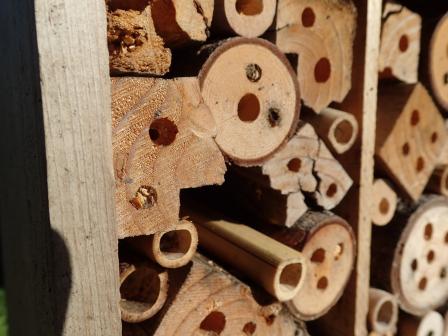Celebrating 50 Years of Earth Day through Greening EPA Facilities
Posted April 21, 2020
 Goats from a local farm eat through overgrowth and invasive species at EPA’s Narragansett, Rhode Island, lab.This year, April 22nd marks the 50th anniversary of Earth Day, a day celebrated by millions of people across the world. Since the first Earth Day in 1970, the United States has made tremendous progress improving air quality, cleaning up contaminated lands, and protecting our bodies of water. As part of that progress, EPA is working hard to ensure all Americans have a clean, healthy environment and a more prosperous future.
Goats from a local farm eat through overgrowth and invasive species at EPA’s Narragansett, Rhode Island, lab.This year, April 22nd marks the 50th anniversary of Earth Day, a day celebrated by millions of people across the world. Since the first Earth Day in 1970, the United States has made tremendous progress improving air quality, cleaning up contaminated lands, and protecting our bodies of water. As part of that progress, EPA is working hard to ensure all Americans have a clean, healthy environment and a more prosperous future.
One small contribution to that effort is the greening of EPA facilities. EPA implements a range of strategies to reduce the environmental impact of facilities and operations, from improving energy conservation to planting pollinator gardens. A few sustainable practices taking place at the Office of Research and Development’s labs and facilities across the country, include:
Protecting Pollinator Habitat
Pollinators, such as bees, butterflies, and bats, contribute to healthy ecosystems as they are responsible for helping 90 percent of the world’s flowering plants reproduce. EPA is working to promote pollinator health by establishing and protecting native pollinator habitats at EPA facilities. In 2003, ORD’s lab in Duluth, Minnesota, turned a substantial portion of its lawn into a northern prairie meadow by eliminating invasive plants and planting a diverse mix of native wildflowers. The facility annually evaluates and maintains the pollinator-friendly plant species and removes the non-native species to enhance the proliferation of bees, butterflies and birds. In 2018, the facility planted 80 new milkweed plants.
 Mason Bee housing in the Corvallis, Oregon, Pollinator Garden.
Mason Bee housing in the Corvallis, Oregon, Pollinator Garden.
EPA's campus in Research Triangle Park, North Carolina, has mason bee boxes and a pollinator garden that was recognized in 2015 as a Monarch Waystation, providing necessary resources to sustain migrating monarchs on their journeys each spring and fall.
EPA’s Corvallis, Oregon, lab planted a pollinator garden with 700 native plants in 2015. Since then, they’ve installed a milkweed meadow and more pollinator gardens, which feature a honeybee hive and a “bee hotel” to accommodate mason bees and other solitary nesting bees. In 2018, the facility added two small wetlands to the meadow, and had it certified as a Monarch Waystation.
EPA’s lab in Gulf Breeze, Florida, is located on a peninsula, so they have planted native, salt-tolerant flowering vegetation that attracts pollinators. In recent years, the facility started letting segments of previously mowed areas go natural to support healthy native, pollinator-friendly plant communities.
One EPA facility is taking a unique approach to protecting pollinators. Since 2016, EPA’s Narragansett, Rhode Island, lab has invited goats from a local farm to eat their way through the facility’s overgrowth each summer. By doing so, the facility protects pollinator habitat from invasive species, creates space for new pollinator-friendly species to grow, and clears vegetation for ground-nesting pollinators.
Conserving Energy
Due to the nature of scientific research and the need for high ventilation rates to maintain indoor air quality, laboratories are significantly more energy-intensive than office buildings. EPA is taking many steps to reduce the energy used at labs. For example, EPA’s lab in Narragansett, Rhode Island, has been replacing traditional fume hoods with more efficient, lower flow fume hoods and upgrading the existing building automation system, which is used to control the building's heating, ventilation and air conditioning, lighting and other systems. These and other planned changes have the potential to result in an annual energy savings of 4.5 billion British thermal units (Btus) when completed.
EPA’s second largest research facility, located in Cincinnati, Ohio, underwent a multi-year infrastructure replacement project that involved replacing mechanical systems, controls and equipment that were more than 30 years old with modern, more efficient models. The updates include a heat recovery system that recaptures heating and cooling energy from the exhaust system and uses it to pre-heat or pre-cool the incoming air and high-performance fume hoods that can be operated at lower air flows and hibernated when not in use.
Additionally, the Corvallis lab is currently undergoing a high-performance sustainable building renovation which will include the installation of a geothermal heat pump system to save energy, a green roof to cover the new annex building, and permeable pavers in the visitor parking area.
These are just a few examples of how EPA is implementing strategies to reduce the environmental impact of labs and facilities across the country. Learn more by checking out some of the resources below.
